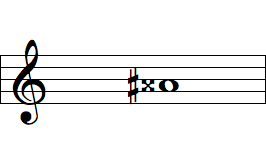Accidentals
Basic Accidentals
Alternate Notation for Double Accidentals
The following accidental symbols (though rarely used) may be found in some compositions. They are not common and may provide a level of confusion for an experienced performer because they are redundant. It is more practical to simply place the appropriate accidental symbol in front of the note. Since these accidental symbols are typically used in highly chromatic passages (passages with lots of accidentals), it makes sense to simplify the notation with as few accidental symbols as necessary. This means that the performer must only process the critical information. The recommended notation is shown on the right.
Alternate
Accidentals
Recommended
Accidentals




There is no specific name for the combined symbols (natural & flat, natural & sharp). In the case of a double flat note, the placement of a natural symbol next to a flat symbol (as shown in the second note on the left example) would logically translate into the natural symbol canceling the first flat of the double flat shown on the first note. So the first note with the double flat would lower the written pitch (C) by two semitones. The second note with a natural symbol and a flat symbol would lower that written pitch (C) only one semitone. The example on the right is the preferred notation since it shows the same pitches and is easier for the performer to read. Same concept applies to a double sharp note.




The double natural symbol is a theoretical accidental symbol and is not used in common practice. The double natural is very confusing and redundant, because there is no functional difference between a double natural symbol and a regular natural symbol. Both symbols cancel any alteration of the pitch from prior accidentals. With the examples on either side of this, the actual written pitch (C) would be performed. Thus, it is more useful to avoid the use the notation shown on the left and use the accepted notation shown on the right.
Triple Accidentals
courtesy accidental
A notation that is often placed before any note that is in a measure following a measure where that same note had been previously altered. The accidental sign is often placed in parentheses to designate that this is a courtesy accidental and is the original note value before alteration. The use of parentheses is used at the discretion of the composer or editor.








